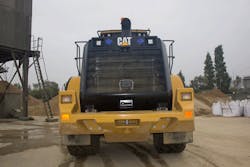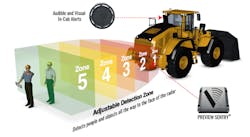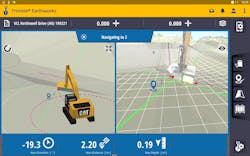As manufacturers redesigned heavy equipment to accommodate the engine technologies required to meet Tier 4-F emissions standards, one area had immediate safety implications.
The compartments containing the engine and its aftertreatment grew in size, and the new hoods and slopes reduced visibility from the cab, particularly to the rear. Although rear-view cameras address this safety issue, extra “eyes” on machines enhance the safety not only of the operator, but anyone or anything nearby.
“Cameras are passive warning devices,” says Corey Heniser, CEO of Brigade. “They only work if you’re staring at the monitor.”
Fleet managers are complementing cameras with tools such as radar detection systems, white-noise alarms, and augmented reality to improve safety conditions.
Brigade’s Backsense radar is designed to detect people and objects in blind spots during harsh weather conditions.
“If an operator is busy in the cab, the backup camera is great—if he’s looking at it,” Heniser says. “But if he’s not, this radar can actually tap him on the shoulder and say, ‘You have a danger on this side of the vehicle.’”
The Backsense radar uses frequency modulated continuous wave (FMCW) technology to transmit an object’s radar frequency to the driver in-cab. The system can work in conjunction with a camera monitor system or as a standalone audible alert.
“The radar shoots out a signal and can detect an object from the bounce back of that signal,” Heniser says. “It can be mounted on any vehicle, and can go out 30 feet or more with a wide angle field of view.”
Users can also program their own detection area and distance. When paired with a camera, an on-screen display will warn drivers of obstacles by overlaying audible and visual data onto the monitor.
“We also offer a mobile digital recorder that we can feed all this data into,” Heniser says. “Whatever the operator is seeing on the cameras, and what the sensors are picking up, we can report that video from the overlay on the screen. If there is an accident, it can be accessed and you can witness what occurred.”
Sensata Technology’s Preco PreView Side Defender II detects moving hazards on the sides of vehicles when making a lane change, and alerts operators to moving cyclists and pedestrians. The system actively warns operators with audible and visual alerts, and has the ability to integrate with telematics applications, vehicle control systems, or other sensors and alarms.
According to Sean Martell, Preco’s North America sales manager, radar is one of the most effective safety technologies for all weather and environmental conditions.
“Radar is still the most reliable hazard detection technology available today when used in adverse conditions,” he says. “It is extremely important to know that this technology can be counted on to be reliable and effective for hazard awareness around the vehicle.”
Preco radar technology’s primary hazard concern is detecting humans.
“Our technology is focused on saving people from blind spot accidents,” he says. “In the world of radar, humans are a small target and challenging to detect. We intend on advancing that technology even further in the future.”
Jeff Bonnema, VP of fleet operations at Ozinga, uses Sensata's Preco radar detection systems on Ozinga’s fleet of ready-mix trucks. The group provides concrete building materials across the Midwest and South Florida.
“We originally tried to add mirrors at the front of the hoods, and it just wasn’t working,” he says. “The sensors are useful in Chicago and the suburbs where there is a lot of foot traffic. Especially when trucks are parked on a job site or on the side of the road, we get a lot of people walking in front of the trucks.”
Last fall, the team installed Sensata’s Preco PreView Side Defender II sensors on five trucks in Florida. The system uses a radar sensor to detect dangers outside the cab. Blinking lights illuminate the in-cab display and a “beep” is emitted if a threat is detected when the turn signal is activated. The team intends to add sensors to 80 additional trucks in the near future.
“We have a lot of problems with side swipes, especially in the Miami area where little sports cars are cutting in and out of traffic,” Bonnema says. “Drivers can’t see the little car, even with the mirrors and cameras. So we placed these on the passenger side of the front steps, and that covers from the front of the bumper to the rear of the truck. It’s been working great so far.”
Ozinga also uses PreView Sentry, a blind spot monitor. Sentry has the ability to detect objects from the face of the radar up to 98 feet.
“With the front Sentry radar, one blinking light inside the cab means the threat is far away,” he says. “More blinking lights—and there are five zones—means it’s getting closer. As we started to roll these out, it’s becoming a mandatory thing that gets installed in our trucks. We’re now spec’ing them from the factory that way to make sure even before they hit the street, they’re installed.”
Bonnema has also discussed taking the systems off-road in the future.
“We have a lot of wheel loaders, so off-road use might happen down the line,” he says. “First we started working with cameras to help our operators out, but it’s getting to the point where there are too many screens inside. It clogs up the cab, and the driver loses focus on which one they should be looking at. So the next step is putting some of these audible-only sensors on our wheel loaders that run around the plants and inside construction zones.”
Brigade also offers bbs-tek, a back up alarm that uses a range of white sound frequencies instead of beeps. The alarm enables the listener to instantly locate what direction the sound is coming from.
“The alarm makes more of a ‘ssh-ssh’ sound, almost like TV static,” Heniser says.
Rear blind spots are a serious safety hazard, regardless of vehicle or machine. Reversing vehicles now account for a quarter of all workplace deaths, with 90 percent of reversing accidents occurring off-road, according to Brigade.
“When you’re hearing so many things all day on site, you start to tune out the beeping sounds,” Heniser says. “High-piercing, tonal alarms are difficult to determine which direction the sound is coming from.”
The alarm’s broadband sound also gives workers wearing hearing protection devices a better chance of hearing it. The white noise alarm can operate effectively at 5 decibels lower than a conventional beeping alarm, according to the company.
“Nothing is heard on the sides,” he says. “You only hear this alarm where you need to hear it.”
The company’s Quiet Vehicle Sounder also uses bbs-tek technology, which is placed on the front of electric and hybrid-electric vehicles. Its pitch and volume increase with vehicle speed to warn nearby road users.
“EVs are very quiet,” Heniser says. “If they’re just rolling in a parking lot at a low speed, all you’ll hear are the tires on the road.”
The company eventually plans to pair the alarm with a predictive sensor that will detect an object and calculate its potential to cross paths.
“The alarm uses algorithms of distances and trajectory,” he says. “We don’t have one here in the U.S. yet, but it should be released in the first quarter of [2021].”
Proximity alarms exclusively for overhead power lines also complement in-cab cameras. Sigalarm offers various tracking devices that can be fitted on both new and used equipment. If an operator is working too close to a power line, an alarm sounds inside the cab.
“Overhead high-voltage power line contact is a known problem,” says Lance Burney, Sigalarm CEO. “This alarm ensures the operator themselves, or anyone standing close to the equipment, doesn’t get electrocuted if unintentional contact is made.”
The system can also automatically stop machine hydraulics with auto-shutdown.
“This is a huge supplement to cameras, and very relevant if they’ve got a boom or something that could potentially reach a power line,” Burney says. “The ability to stop movement is critical for side booms, excavators, and machines that aren’t moving heavy loads.”
The system begins detecting at 110 volts AC. The proximity alarm is placed on the boom, and its sensors report to a control module inside the cab. If a job calls for working in close proximity to the power line, the alarm can also be set within a preset distance.
Augmented reality (AR) platforms such as Trimble Earthworks combine a digital space with the physical worksite. When used with an on-cab camera, operators can see virtual design elements—such as avoidance zones—superimposed over the real site.
“This allows operators to visualize the design in relation to the site,” says Cameron Clark, earthmoving industry director at Trimble. “If they are in the cab of the excavator and they look around or rotate the machine, they can see what they have to build and how it relates to the ground as it stands today.”
With AR, operators are also able to determine the location of underground utilities with respect to their bucket. This provides more spatial knowledge, and shows an operator what the job requires before breaking ground.
“Instead of looking at a digital screen where you’re not sure where things are, you can superimpose these areas through the eyes of the operator using AR,” Clark says. “You can draw those areas through the camera and see exactly where they are on the ground.
“If there’s a conflict in the design, or maybe something is just completely wrong...you have a way to visualize what the final product is. You can bring a lot more confidence.”
Trimble Earthworks also brings greater awareness around the bucket of the excavator.
“If an operator is working in a trench, a lot of the time you’ll see people in the trench laying pipes, and you’ll see excavator operators standing and looking down into the trench,” Clark says. “This is very dangerous because they’ll stand up, look over, sit back down, get up again, and a lot of the time they don’t actually disengage the hydraulics.”
If an operator accidentally bumps a lever in the cab, the boom can swing and potentially hit someone.
“With the camera on the machine you can actually see at a better angle into the trench without having to stand up and look over,” he says. “It provides another angle to see all around, and give greater awareness.”
About the Author
Gianna Annunzio
Gianna was associate editor from 2018 - 2021.


